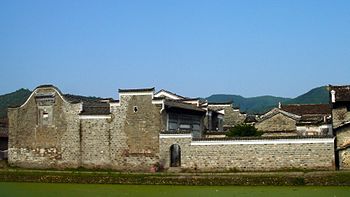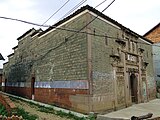Architecture of Jiangxi

Architecture of Jiangxi refers to the traditional masonry houses, residential compounds, monuments, and academies built in Jiangxi Province of East China.
Overview
Architectural features
Materials
Natural materials are very much preferred. Raw materials, such as stone, wood, and brick, are abundantly used for the respect for nature. Stone, as the fundamental part in the construction, is variable across different regions; sandstone, limestone, granite are the most frequent choices. Wood is generally used for the framework of buidings, because of its warmth and workability.
Fengshui design
Jiangxi school
Building types
Jiangxi residential architecture is renowned for its exterior and interior design, relating to the surrounding context and settings by using Fengshui principles.
The traditional houses still preserved in Jiangxi were mostly built during the Ming dynasty and Qing dynasty. These buildings are characterized by gables of dark bricks, with white lines under eaves, covered by black tiles. They are often elaborately decorated by wood, stone and brick carvings, ink painting, clay sculpture, and sometimes Nuoxi elements.
Important historical monuments built in Jiangxi in the traditional styles include ancestral shrines, Shuyuan (Confucian) academies, and paifang (memorial arches).
Residential architecture
Memorial architecture
Educational architecture
Religious architecture
Decorative structures
Stone carving
Brick carving
Wood carving
Ink painting
Infrastructure
Defensive wall
Road
Bridge
Water well
Significant buildings and areas
Major National Historical and Cultural Sites
Influence on neighbourhood
Regional difference
Gallery
Ancestral halls and shrines
-
Ancestral shrine in Ji'an
-
Huangcun Jingyitang, Wuyuan County, Jiangxi.
-
Door of Huangcun Jingyitang.
-
Bed chamber of Huangcun Jingyitang.
-
Yu Family Ancestral Hall, Wangkou Village.
-
More Yu Family Ancestral Hall.
Pavilion
-
Pavilion of Prince Teng at Nanchang, Front view.
-
Pagoda of Prince Teng.
-
A picture of Pavilion of Prince Teng.
City Wall
-
Ganzhou's City Wall.
Others
-
Imperial Kiln in Jingdezhen.














